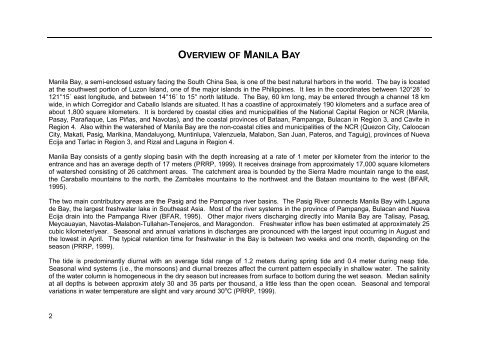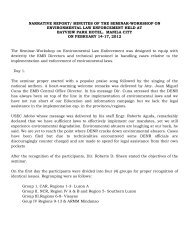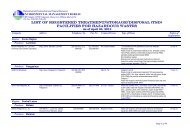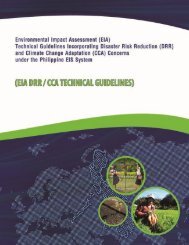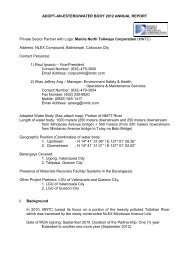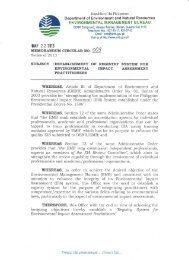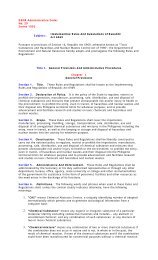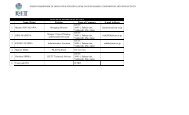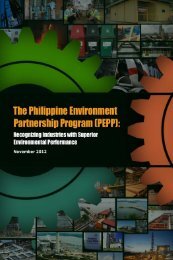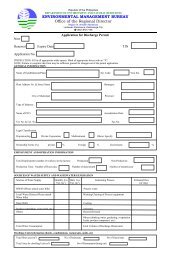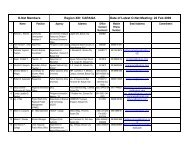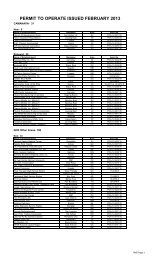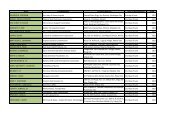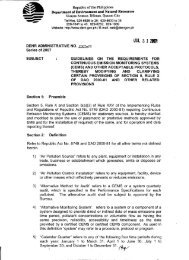An Overview of Manila Bay - Environmental Management Bureau
An Overview of Manila Bay - Environmental Management Bureau
An Overview of Manila Bay - Environmental Management Bureau
Create successful ePaper yourself
Turn your PDF publications into a flip-book with our unique Google optimized e-Paper software.
OVERVIEW OF MANILA BAY<br />
<strong>Manila</strong> <strong>Bay</strong>, a semi-enclosed estuary facing the South China Sea, is one <strong>of</strong> the best natural harbors in the world. The bay is located<br />
at the southwest portion <strong>of</strong> Luzon Island, one <strong>of</strong> the major islands in the Philippines. It lies in the coordinates between 120°28´ to<br />
121°15´ east longitude, and between 14°16´ to 15° north latitude. The <strong>Bay</strong>, 60 km long, may be entered through a channel 18 km<br />
wide, in which Corregidor and Caballo Islands are situated. It has a coastline <strong>of</strong> approximately 190 kilometers and a surface area <strong>of</strong><br />
about 1,800 square kilometers. It is bordered by coastal cities and municipalities <strong>of</strong> the National Capital Region or NCR (<strong>Manila</strong>,<br />
Pasay, Parañaque, Las Piñas, and Navotas), and the coastal provinces <strong>of</strong> Bataan, Pampanga, Bulacan in Region 3, and Cavite in<br />
Region 4. Also within the watershed <strong>of</strong> <strong>Manila</strong> <strong>Bay</strong> are the non-coastal cities and municipalities <strong>of</strong> the NCR (Quezon City, Caloocan<br />
City, Makati, Pasig, Marikina, Mandaluyong, Muntinlupa, Valenzuela, Malabon, San Juan, Pateros, and Taguig), provinces <strong>of</strong> Nueva<br />
Ecija and Tarlac in Region 3, and Rizal and Laguna in Region 4.<br />
<strong>Manila</strong> <strong>Bay</strong> consists <strong>of</strong> a gently sloping basin with the depth increasing at a rate <strong>of</strong> 1 meter per kilometer from the interior to the<br />
entrance and has an average depth <strong>of</strong> 17 meters (PRRP, 1999). It receives drainage from approximately 17,000 square kilometers<br />
<strong>of</strong> watershed consisting <strong>of</strong> 26 catchment areas. The catchment area is bounded by the Sierra Madre mountain range to the east,<br />
the Caraballo mountains to the north, the Zambales mountains to the northwest and the Bataan mountains to the west (BFAR,<br />
1995).<br />
The two main contributory areas are the Pasig and the Pampanga river basins. The Pasig River connects <strong>Manila</strong> <strong>Bay</strong> with Laguna<br />
de <strong>Bay</strong>, the largest freshwater lake in Southeast Asia. Most <strong>of</strong> the river systems in the province <strong>of</strong> Pampanga, Bulacan and Nueva<br />
Ecija drain into the Pampanga River (BFAR, 1995). Other major rivers discharging directly into <strong>Manila</strong> <strong>Bay</strong> are Talisay, Pasag,<br />
Meycauayan, Navotas-Malabon-Tullahan-Tenejeros, and Maragondon. Freshwater inflow has been estimated at approximately 25<br />
cubic kilometer/year. Seasonal and annual variations in discharges are pronounced with the largest input occurring in August and<br />
the lowest in April. The typical retention time for freshwater in the <strong>Bay</strong> is between two weeks and one month, depending on the<br />
season (PRRP, 1999).<br />
The tide is predominantly diurnal with an average tidal range <strong>of</strong> 1.2 meters during spring tide and 0.4 meter during neap tide.<br />
Seasonal wind systems (i.e., the monsoons) and diurnal breezes affect the current pattern especially in shallow water. The salinity<br />
<strong>of</strong> the water column is homogeneous in the dry season but increases from surface to bottom during the wet season. Median salinity<br />
at all depths is between approxim ately 30 and 35 parts per thousand, a little less than the open ocean. Seasonal and temporal<br />
variations in water temperature are slight and vary around 30 o C (PRRP, 1999).<br />
2


